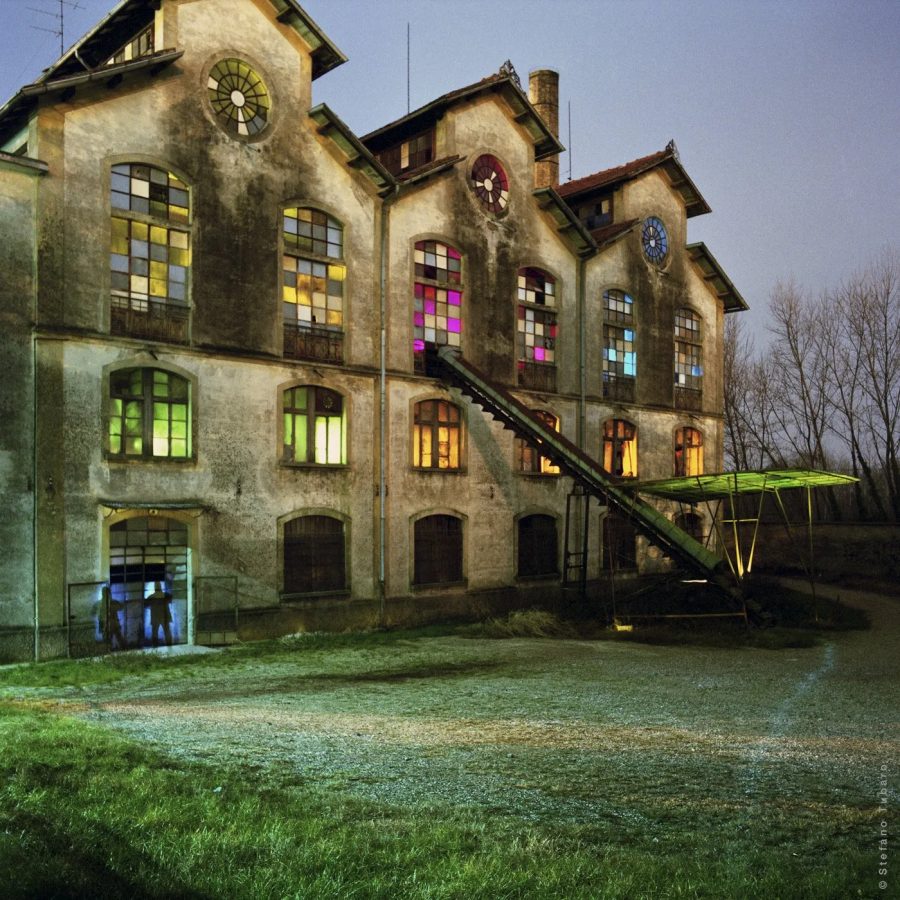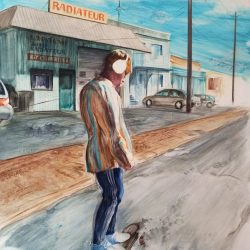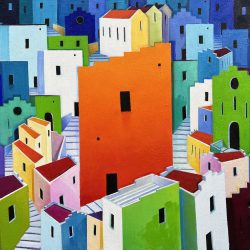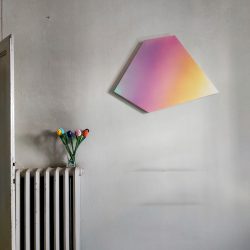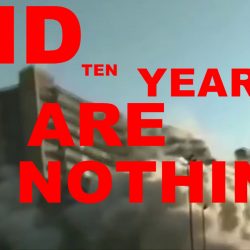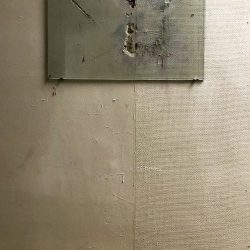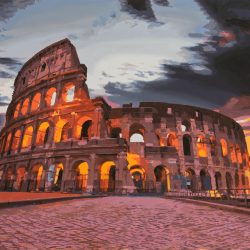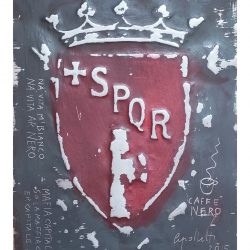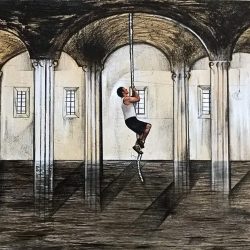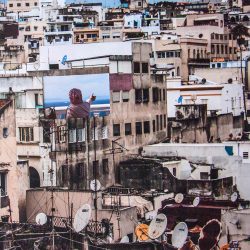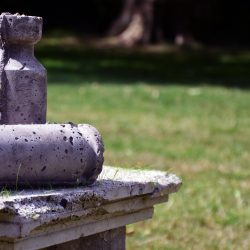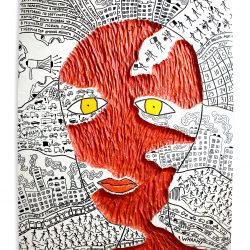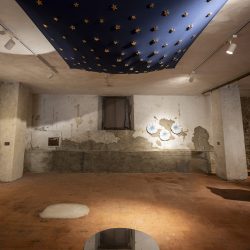work
Contrattempo#Dignano
| category | Photography |
| subject | Architecture |
| tags | archeologia industriale, luce artificiale, tempo, storico, notturno, illuminazione , fotografia analogica, abbandonato, dismesso |
| base | 100 cm |
| height | 100 cm |
| depth | 0 cm |
| year | 1998 |
Stefano Tubaro | project “Setbacks” | 1997 - 2002
•
Setback#Dignano, chromogenically developed photographic print from negative film, photosensitive paper assembled on aluminium, 3 copies
•
Nobody is born from sea foam any more. Even the work of Stefano Tubaro, at first sight so surprising in the current panorama of photography, has - fortunately for him - many roots, some of which go back a long way. The first thing that strikes one in Tubaro's images is the contrast between the environmental context, degraded or in any case placed on the fringes of current events, and the play of light that invests it with a hyper-technological intensity that has great analogies only with that of the stages of great rock concerts. If, however, one goes to investigate how these effects were obtained, one discovers that they are the result of a recovery of lighting techniques already used in the last century by the Alinari. These, in fact, in order to obtain their famous images readable in every detail despite the fact that the buildings were drowned in the cramped spaces of the old cities, 'brushed' the large surfaces with beams of light during very long exposure times. And that is exactly what Tubaro says he did. One has to believe him, otherwise one would not explain the presence of ghostly figures in his photographs, which are nothing more than the trails left by the author himself as he moves about in the poor evening light 'brushing' the buildings with multi-coloured lights. These photographs, with a very strong visual impact, actually have a very complex structure in which unusual execution times and unusual operating techniques concur. Their scenographic appearance should not mislead; it conceals their author's desire to enter into the images themselves with his whole body. What does all this mean if not that Tubaro, feeling the need to blend in, to 'blend' with his own images, expresses a reaction to the flood of virtual images that deny any authentic physicality?
Franco Vaccari
(text of presentation for the travelling exhibition at: Fondazione Italiana per la Fotografia, Turin; Chiesa SS. Quirico e Siro, Pavia; Chiesa del Suffragio, Savignano sul Rubicone; Galleria dell'Ecole d'Arts Appliquès, Vevey-Switzerland, 1999)
Several elements come together in this colourful research by Stefano Tubaro. A series of abandoned places, disused structures, are chosen as objects of attention not in a descriptive-documentary key, but as small theatres of events. The author - it is important to emphasise - performs real actions, and of a certain duration: standing in the dark he animates the space, illuminates parts of it for a long time and then shoots. It is light, then - the very basis of photography - that intervenes on physical reality, creating areas of colour that 'revitalise' architecture that no longer functions, suddenly moving it from the real to the dreamlike plane. The work, although strongly designed, leaves an important opening for chance, as the final outcome of the image is not entirely predictable (it may have 'mishaps'), and this further emphasises the importance of the interaction between scene setting and subsequent shooting. It is then a question of a landscape truly created 'live' through light, according to an operation of distant land art ancestry, which the photographic shot defines, and not, as it might appear, of images realised through digital colouring done a posterior. This superimposition of light/colour reality on physical reality finds in the final photographic shot a kind of consecration beyond which it is meaningless to go, as on the contrary would be the case in the digitally processed image, which is all resolved after the shot. That it is rather the human element - and not the weight of technology - that determines the identity of these photographic works is confirmed by the presence in silhouette of a figure, the author himself, who thus also visually affirms his presence in the various phases of the operation. The use of sharp, well-defined colours, and this superimposition of artificial colour on top of natural colour, grafts certain codes of painting or illustration onto Tubaro's purely photographic images, introduces a sense of fairytale, of an 'other' place, and at the same time alludes to the separation of colours, which is at the root of the very sense of light as well as the basis of all mechanical reproduction techniques, for example typography and silk-screen printing, which in turn are arts that, like photography, have as their starting point precisely and exactly the vital element of light.
Roberta Valtorta
(text of presentation in the exhibition catalogue "Contrattempi di scena", Galleria Artestudio Clocchiatti, Udine, 2000)
•
Setback#Dignano, chromogenically developed photographic print from negative film, photosensitive paper assembled on aluminium, 3 copies
•
Nobody is born from sea foam any more. Even the work of Stefano Tubaro, at first sight so surprising in the current panorama of photography, has - fortunately for him - many roots, some of which go back a long way. The first thing that strikes one in Tubaro's images is the contrast between the environmental context, degraded or in any case placed on the fringes of current events, and the play of light that invests it with a hyper-technological intensity that has great analogies only with that of the stages of great rock concerts. If, however, one goes to investigate how these effects were obtained, one discovers that they are the result of a recovery of lighting techniques already used in the last century by the Alinari. These, in fact, in order to obtain their famous images readable in every detail despite the fact that the buildings were drowned in the cramped spaces of the old cities, 'brushed' the large surfaces with beams of light during very long exposure times. And that is exactly what Tubaro says he did. One has to believe him, otherwise one would not explain the presence of ghostly figures in his photographs, which are nothing more than the trails left by the author himself as he moves about in the poor evening light 'brushing' the buildings with multi-coloured lights. These photographs, with a very strong visual impact, actually have a very complex structure in which unusual execution times and unusual operating techniques concur. Their scenographic appearance should not mislead; it conceals their author's desire to enter into the images themselves with his whole body. What does all this mean if not that Tubaro, feeling the need to blend in, to 'blend' with his own images, expresses a reaction to the flood of virtual images that deny any authentic physicality?
Franco Vaccari
(text of presentation for the travelling exhibition at: Fondazione Italiana per la Fotografia, Turin; Chiesa SS. Quirico e Siro, Pavia; Chiesa del Suffragio, Savignano sul Rubicone; Galleria dell'Ecole d'Arts Appliquès, Vevey-Switzerland, 1999)
Several elements come together in this colourful research by Stefano Tubaro. A series of abandoned places, disused structures, are chosen as objects of attention not in a descriptive-documentary key, but as small theatres of events. The author - it is important to emphasise - performs real actions, and of a certain duration: standing in the dark he animates the space, illuminates parts of it for a long time and then shoots. It is light, then - the very basis of photography - that intervenes on physical reality, creating areas of colour that 'revitalise' architecture that no longer functions, suddenly moving it from the real to the dreamlike plane. The work, although strongly designed, leaves an important opening for chance, as the final outcome of the image is not entirely predictable (it may have 'mishaps'), and this further emphasises the importance of the interaction between scene setting and subsequent shooting. It is then a question of a landscape truly created 'live' through light, according to an operation of distant land art ancestry, which the photographic shot defines, and not, as it might appear, of images realised through digital colouring done a posterior. This superimposition of light/colour reality on physical reality finds in the final photographic shot a kind of consecration beyond which it is meaningless to go, as on the contrary would be the case in the digitally processed image, which is all resolved after the shot. That it is rather the human element - and not the weight of technology - that determines the identity of these photographic works is confirmed by the presence in silhouette of a figure, the author himself, who thus also visually affirms his presence in the various phases of the operation. The use of sharp, well-defined colours, and this superimposition of artificial colour on top of natural colour, grafts certain codes of painting or illustration onto Tubaro's purely photographic images, introduces a sense of fairytale, of an 'other' place, and at the same time alludes to the separation of colours, which is at the root of the very sense of light as well as the basis of all mechanical reproduction techniques, for example typography and silk-screen printing, which in turn are arts that, like photography, have as their starting point precisely and exactly the vital element of light.
Roberta Valtorta
(text of presentation in the exhibition catalogue "Contrattempi di scena", Galleria Artestudio Clocchiatti, Udine, 2000)



